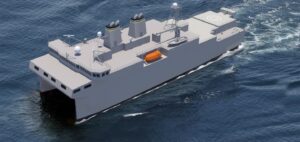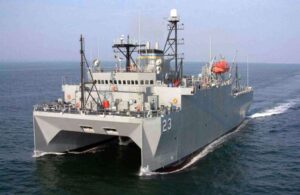The Navy awarded Austal USA a $516 million contract modification on May 30, exercising an option for ordering long-lead time material and to continue/complete detail design and construction (DD&C) work on the first T-AGOS 25 class ocean surveillance ship.
Last year, the Navy awarded Austal a contract starting at $114 million to start DD&C work, but with options worth up to $3.2 billion for the planned seven ships in the class (Defense Daily, May 19, 2023).

According to a Congressional Research Service (CRS) report released in March, procurement work on the first T-AGOS 25-class ship was first awarded in fiscal year 2022 at a price of $434 million.
However, the FY 2024 budget request showed the ship’s estimated cost increased to $789.6 million, nearly an 82 percent increase. The FY ‘24 budget documents sought $355 million for more cost-to-complete funding to pay for the cost growth while planning to procure the second ship in FY 2025.
The Navy’s FY 2024 budget request documents said this cost growth was caused by “several factors affecting shipbuilding prices including direct material inflation, supply chain challenges, and increased non-recurring engineering costs.”
The most recent FY 2025 budget request said the Navy now wants to procure the second through fifth ships one per year over FY 2026 to 2029, with none requested for FY 2025 amid budget caps.
The FY ‘25 budget documents said T-AGOS 25 is now expected to be delivered in July 2027, with the remaining ships planned to be delivered annually between early 2029 and 2032.
The service plans to use the T-AGOS 25-class to replace the current five aging T-AGO ships that entered into service from 1991-1992 and one that entered into service in 2000. All of the ships have been homeported at Yokohama, Japan.
The CRS report said part of the reason the Navy may want to replace the T-AGOS vessels is “as a response by the Navy to the submarine modernization efforts of countries such as China and Russia.”

Navy budget documents note these ships gather underwater acoustical data to support the integrated undersea surveillance system mission by providing a platform capable of theater anti-submarine acoustic passive and active surveillance.
T-AGOS ships, which are operated by Military Sealift Command, use Surveillance Towed-Array Sensor System (SURTASS) equipment to gather undersea acoustic data and carry electronic equipment to process and transmit that data via satellite to shore stations for evaluation.
The CRS report also noted Navy budget plans indicate the service seems to have increased procurement costs for the sixth and seventh ships in the class, but not the second to fifth ship costs. Notably, the Future Years Defense Plan only extends to five years and does not cover the last two T-AGOS 25 ocean surveillance ships.